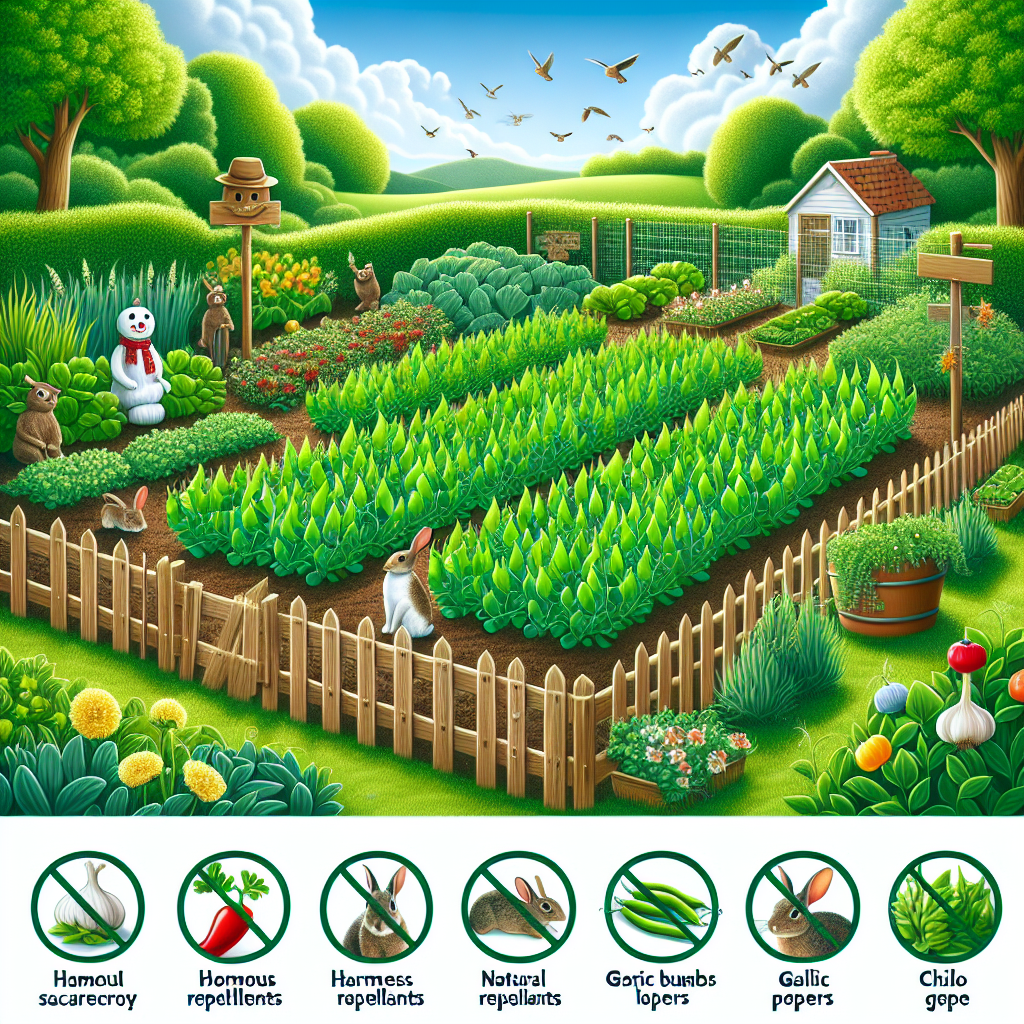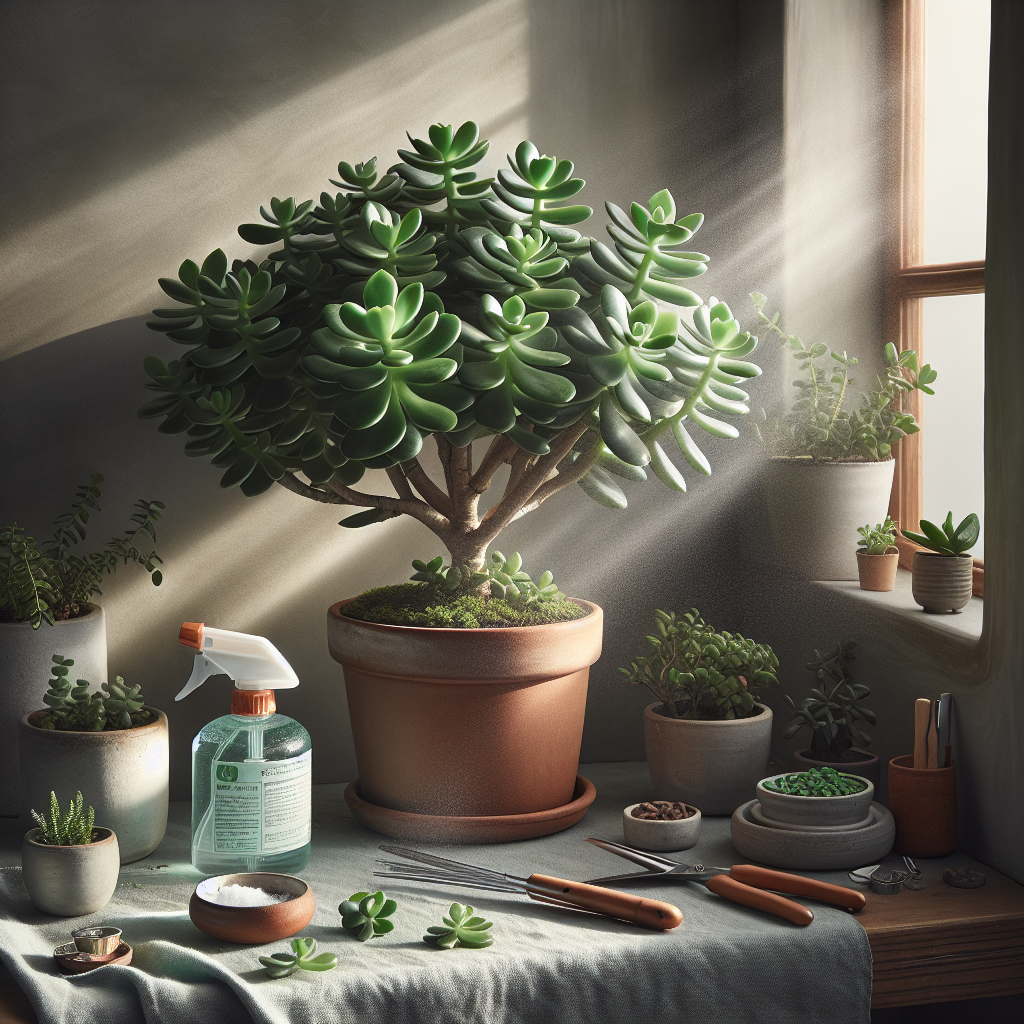Deterring Rabbits from Feasting on Peas
Updated June 25, 2024 at 11:17 pm
Discover effective strategies to protect your pea plants from the persistent appetite of rabbits, ensuring a bountiful harvest without the unwanted nibbling.

“`html
Understanding the Pesky Bunny: Identifying the Culprit
If you’re noticing bite marks on your pea plants or entire crops disappearing overnight, you might be dealing with rabbits. These cute but troublesome critters are known for their appetite for tender garden greens, especially young pea shoots.
Before we dive into solutions, let’s identify the signs of rabbit presence. You’ll often see rounded droppings, nibbled leaves, and possibly tracks around your garden. If these telltale signs ring a bell, it’s time to take action against your fluffy adversaries.
Fortifying Your Garden: Natural Barriers and Fences
Establishing a physical barrier can be one of the most effective ways to keep rabbits at bay. A fence that’s at least 2 feet tall made of chicken wire, with the bottom buried 6 inches deep, can deter even the most persistent of bunnies.
For those who prefer a more aesthetic approach, consider planting protective borders around your peas. Marigolds and garlic can serve as natural deterrents and add a pop of color and fragrance to your garden.
The Scent of Security: Using Repellents to Ward Off Rabbits
Rabbits rely heavily on their sense of smell, so using scent-based repellents can be an effective way to keep them away from your peas. Commercial products like Liquid Fence and Nature’s Mace Rabbit Repellent have been noted for their effectiveness by several users.
Based on reviews, Liquid Fence has been praised for its ability to deter rabbits without harming them or the environment. Users appreciate its long-lasting formula which means fewer reapplications, making it a convenient and eco-friendly option.
Find This and More on Amazon
Maintaining a Balance: Inviting Natural Predators
By encouraging natural predators into your garden, you can create a biological control against rabbits. Owls, hawks, and even domesticated pets like cats or dogs can keep rabbits from feeling too cozy in your backyard.
Consider installing a birdhouse or perch to invite predator birds that can keep the rabbit population in check. Remember, the goal is to create a balance in the ecosystem, not eliminate one part of it.
Scare Tactics: Utilizing Decoys and Noise Machines
Setting up decoys that resemble predators, such as fake owls or snakes, can provide a good scare to unsuspecting rabbits. Alternating the positions of these decoys can increase their effectiveness as rabbits may become accustomed to static objects over time.
Noisemakers such as ultrasonic repellents or wind chimes can also create an uncomfortable environment for rabbits. The unexpected noises discourage them from foraging in your garden, providing you with another layer of defense.
Companion Planting: Allies in the Garden
Companion planting is a strategy that involves planting certain types of plants near each other to naturally repel pests. For instance, onions and leeks can be strong allies when planted near peas, as their scents tend to deter rabbits.
This not only helps in deterring rabbits but also promotes biodiversity and can improve the overall health of your garden. It’s a win-win situation for you and your vegetable patch.
Timely Tricks: Adjust Your Gardening Schedule
Rabbits are most active during dusk and dawn. If possible, try to tend to your garden during midday when rabbits are less likely to be around. By doing so, you reduce the chance of encounters and make your presence felt, which can discourage rabbits from visiting.
Additionally, being strategic about when you plant your peas can help. Delaying planting by a few weeks might mean your pea plants are stronger and less appealing to rabbits when they begin their spring feasting.
Creating Unfavorable Conditions: Soil and Mulch Tactics
Making the soil surface less inviting can deter rabbits from digging and nibbling on your plants. Using prickly mulch like pine cones or holly leaves can make the ground uncomfortable for them to walk on, discouraging them from approaching your peas.
Thick organic mulches can also confuse rabbits, as they hide the plants and make it harder for these critters to locate their next meal. It’s a simple yet effective way to protect your crops.
DIY Repellents: Home Solutions for Rabbit Deterrence
If you’re into homemade solutions, blending hot peppers or garlic with water and applying it around your garden can work as a strong deterrent. Rabbits are sensitive to strong scents and will likely avoid treated areas.
For a personal touch, creating and applying these mixtures can be a cost-effective and satisfying method of protecting your garden without the use of chemicals or commercially produced products.
Frequent Harvesting: Keeping Your Peas Unattractive to Rabbits
Rabbits tend to target young and tender plants, so regular harvesting can make your peas less attractive to them. By picking peas frequently, you encourage the growth of tougher and more mature plants that rabbits typically avoid.
Not only does this method deter rabbits, but it also promotes high yields and a better tasting crop for you to enjoy. So keep an eye on your peas and harvest them as soon as they’re ready.
Seeking Community Insight: Discussions with Local Gardeners
Reaching out to fellow gardeners in your area can provide you with a wealth of knowledge and tips that are specific to dealing with rabbits in your locality. They might even know some tried and true tricks that haven’t hit the mainstream yet.
By connecting with your community, you gain insights into methods that have proven effective in your specific climate and environment, which can save you time and effort in the long run.
Conclusion and Content area 1 of 3
“`
Embracing Technology: Electronic Fencing and Motion Sensors
If you are looking for a more high-tech solution, electronic fencing and motion-activated sprinklers offer a modern approach to deterring rabbits. Electronic fences can deliver a harmless but surprising zap to an unsuspecting rabbit trying to access your peas.
Motion-activated sprinklers, such as the Orbit 62100 Yard Enforcer, can startle rabbits with a burst of water prompted by their movement. Reviews of the Orbit 62100 often highlight its effectiveness not only in deterring rabbits but also deer and other garden intruders.
Find This and More on Amazon
Biodegradable Options: Eco-Friendly Rabbit Deterrents
For those environmentally minded, biodegradable options such as burlap or netting can protect pea plants without damaging the ecosystem. Burlap, in particular, can be draped over plants to create a barrier that rabbits can’t chew through.
Netting products can also offer protection with the added benefit of letting sunlight and water through, ensuring that your pea plants continue to thrive while being shielded from furry invaders.
Chemical-Free Tactics: The Role of Plant Health
Healthy, robust plants are less likely to succumb to rabbit damage. Ensuring that your peas receive optimal nutrition and water can make them less appealing to rabbits, who often target weaker plants first.
Using organic fertilizers and maintaining soil health can strengthen your plants’ defenses. Products like Espoma Organic Garden-Tone have garnered positive reviews for promoting strong plant growth without using chemicals.
Monitoring and Observation: Staying One Hop Ahead
One of the most overlooked strategies is simply to observe your garden regularly. By monitoring your pea plants and the surrounding area, you can detect early signs of rabbit activity and address them before any significant damage is done.
Keeping a garden journal with notes on any rabbit sightings, times of increased activity, and successful deterrents can help you develop an effective, long-term strategy for warding off bunnies.
Combining Strategies for Maximum Effectiveness
It is often not one single method but a combination of tactics that provides the best defense against rabbits. Integrating physical barriers like fences, employing repellents, encouraging natural predators, and maintaining garden health are all strategies that work together synergistically.
By creating a multi-layered approach, you not only make your garden less appealing to rabbits, but you also improve its overall resilience against a variety of pests and challenges.
Learning from Failure: Adapting to Rabbit Behavior
Even the best-laid plans can sometimes fall short, and it’s important to be flexible in your approach. If you’ve tried a method that didn’t work, don’t be discouraged; rabbits can be quite adept at overcoming obstacles.
Use setbacks as an opportunity to learn and tweak your strategies. Being adaptable will help you stay one step ahead of these resourceful creatures and protect your pea harvest.
Investing in Research: Staying Informed About Rabbit Deterrents
With new products and methods constantly emerging, staying informed is key. Researching the latest rabbit deterrents and crop protection methods can reveal new strategies you may not have considered before.
Reading product reviews, gardening blogs, and speaking with experts can provide you with a deeper understanding of what works and what does not in the ongoing battle to protect your peas from rabbits.
Plant Varieties: Choosing Rabbit-Resistant Peas
Another angle to consider is the type of peas you plant. Some varieties may be naturally more resistant to pests due to their taste, structure, or growth habits. Choosing such varieties can reduce the appeal of your garden to rabbits without extra effort on your part.
Consulting seed catalogs or talking to local nursery staff can help you identify which pea varieties have shown resilience in the face of rabbit predation. Planting these could provide you with a head start in safeguarding your vegetables.
Community Initiatives: Neighborly Cooperation for Rabbit Control
Rabbits don’t respect property lines, so it stands to reason that working together with your neighbors can amplify your efforts. Cooperative initiatives like shared fencing or community repellent programs can provide a more robust defense against these critters.
By pooling resources and strategies, you can create a larger, less hospitable environment for rabbits while fostering community relationships. Plus, you might pick up some new gardening tips in the process!
Understanding Local Regulations: Navigating Legal Considerations
Before you implement any measures, especially those that could harm rabbits, be sure to understand local wildlife and animal control regulations. Ensuring that your rabbit deterrents comply with local laws not only protects you legally but also conserves local wildlife populations.
Familiarizing yourself with local regulations can be as simple as visiting your city’s or county’s website or contacting your local extension office. This step is crucial in developing a sustainable and legal strategy for protecting your vegetable garden.
Expanding Your Knowledge: Educational Resources and Workshops
Attending local gardening workshops, joining gardening clubs, or enrolling in online horticulture classes can expand your repertoire of rabbit deterrent techniques. These resources often provide hands-on strategies and allow you to ask questions specific to your situation.
By continually educating yourself, you can keep up with evolving methods and technologies that can aid in protecting your garden from rabbits. Plus, it’s a fantastic opportunity to connect with gardening enthusiasts who share your passion.
The Bottom Line: Persistence Pays Off
Deterring rabbits from your garden is a challenge that requires persistence, creativity, and a willingness to try a variety of strategies. It’s an ongoing process that may require seasonal adjustments and a keen observation of what is effective.
With patience and a proactive approach, you can greatly reduce the chances of rabbits feasting on your peas. As you become more adept at employing these tactics, you’ll find the joy and satisfaction of a bountiful, rabbit-free harvest.
Reflecting on Garden Practices: Integrated Pest Management
Integrated Pest Management (IPM) is a holistic approach that could be particularly valuable in your fight against rabbits. It combines cultural methods, biological controls, physical barriers, and sometimes chemical treatments to manage pest problems effectively and sustainably.
Adopting IPM principles means you’re not just reacting to a problem after the fact; you’re anticipating issues and putting practices in place that could deter pests before they become serious. Balancing these strategies can result in fewer invasions by furry foes in your garden patches.
Specialized Garden Layouts: Raised Beds and Enclosures
The structure of your garden can also have an impact on its vulnerability to rabbits. Raised beds, for instance, can provide a physical challenge to rabbits, especially when the sides are steep and taller than a rabbit’s jump.
Another option could be to grow peas within garden enclosures like cold frames or hoop houses. While these are generally used to extend the growing season, they can also protect young pea plants from rabbits until they’re strong enough to withstand a munch or two.
Garden Gadgets: The Promise of Ultrasonic Rabbit Repellers
Ultrasonic pest repellers emit a sound that is supposed to be intolerable to small animals like rabbits but is undetectable to human ears. Devices such as the Cleanrth CR008 Advanced Ultrasonic Rodent Repelling System have favorable reviews for their effectiveness in repelling various garden pests.
Customers have attested to a notable decrease in rodent and wildlife activity in their gardens after installing these devices. However, it’s essential to read through reviews and understand that results may vary. Consistency and positioning are key factors cited in successful cases.
Organic Practices: Enhancing Soil Fertility
Robust plants start with fertile soil. Composting and using organic matter can improve soil health, which in turn leads to stronger plants that might just fend off rabbit attacks more efficiently.
Organic practices enhance the ecosystem of your garden, promoting beneficial insects and microorganisms that contribute to the overall health of your plants and soil. This can indirectly reduce the severity of all pest invasions, including rabbits.
Gentle Solutions: Humane Traps and Relocation
Humane trapping and relocating rabbits might be an option for some. Live traps baited with tasty treats can capture the critters, which can then be relocated to an area where they won’t cause damage to cultivated plants.
It’s vital, though, to check with local wildlife authorities on the regulations regarding trapping and relocating wildlife. Ensure you’re acting ethically and legally, and consider the well-being of the animals as well as the safety of your pea plants.
Tracking Results: Documenting Garden Changes
Keeping thorough records of what you’ve tried and how effective each tactic was can inform your future decision-making. Photography, notes, or even a simple spreadsheet tracking rabbit activity and plant health can be very useful.
By documenting your results, you can refine your rabbit deterrence over time, focusing on the strategies that work best and dropping those that don’t show as much promise. This personalized record can also be a valuable resource to share with fellow gardeners facing similar issues.
Planting Strategy: Staggering and Diversity
Consider staggering the planting of peas or introducing a diversity of plants that may confuse or deter rabbits. A mixed planting can make it harder for rabbits to hone in on their favorite snacks and may offer some protection to more vulnerable plants.
Diverse planting not only confuses pests but can also improve pollination and reduce the incidence of diseases, which contributes to a more resilient and productive garden ecosystem.
Local Wildlife Sanctuaries: Learning and Volunteering
Understanding local wildlife behavior can also bolster your defense against rabbits. One way to gain this insight is by visiting or volunteering at a wildlife sanctuary or nature reserve, where you can learn directly about the animals’ habits and preferences.
Such involvement can also offer networking opportunities with wildlife experts who might provide guidance on deterring rabbits or even suggest new, innovative methods you haven’t considered.
Summing it Up: Crafting a Rabbit-Resistant Eden
Deterrence is key when it comes to preventing rabbits from feasting on your peas, but remember, a balanced ecosystem where wildlife and plants can coexist is the true end goal. Consider all the methods at your disposal, from fencing to natural repellents, to high-tech solutions like ultrasonic devices.
Though it can be frustrating when rabbits treat your garden as a buffet, remember that these challenges can lead to a more robust understanding of your garden’s ecosystem. With persistence, research, and a little bit of ingenuity, your green haven can thrive, offering a bountiful harvest while coexisting with the surrounding wildlife.
Shop more on Amazon
Flowers & Plants Team
Flowers & Plants Team


